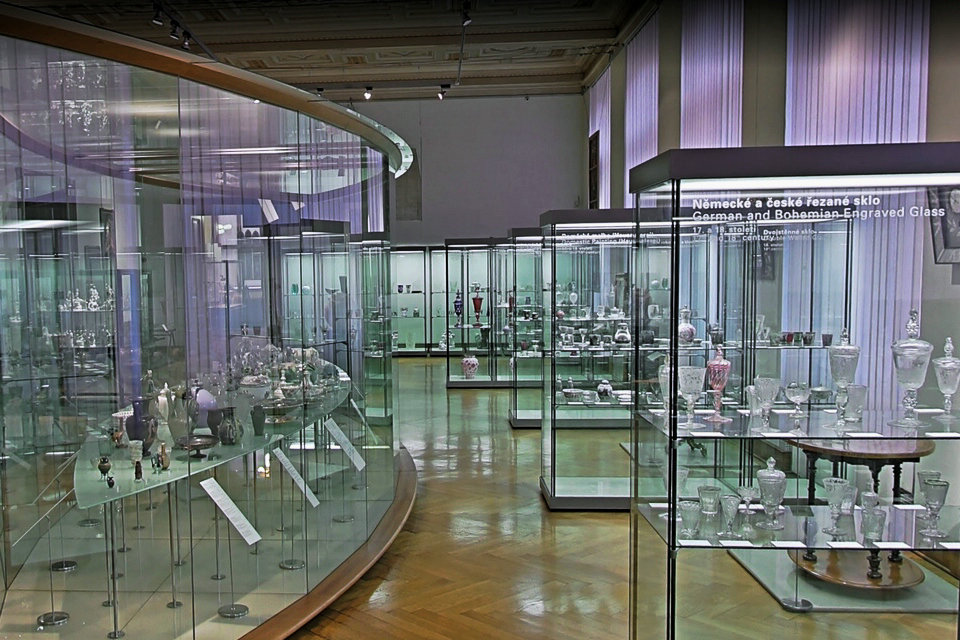Pleiad of Glass 1946–2019, Museum of Decorative Arts In Prague


The exhibition Pleiad of Glass 1946–2019, which has consisted of art-exhibition glass objects, has been expanded to include almost fifty large-scale sculptures from the collections of the Museum of Decorative Arts in Prague.
“Whereas the first hall of the Pleiad of Glass exhibition showcase art glass and is evocative of a sort of museum depository, the second part of the exhibition is different,“ says curator PhDr. Sylva Petrová. “It differs in the types of glass objects, that is, in content, as well as its spatial installation design. The second hall offers mostly large-scale art glass creations that were originally designed and intended for specific architectural spaces, mostly foreign exhibitions. Thanks to the long-term exhibition Pleiad of Glass they are being shown for the first time in the restored exhibition hall of the museum’s historic building. The team entrusted with the preparations of the exhibition thought it correct to facilitate a free dialogue between these remarkable glass sculptures and the building’s unique interior. We have decided so in hope that visitors will enjoy the combined visual impact generated by the masterpieces of Czech art, crafts and design of the 20th and 21st centuries.“
This is why the second hall’s display has a minimum of interfering elements, such as in-built sections that could look like “obstacles” hindering the perception of the hall’s overall space, or the entry of natural and artificial light. Owing to this straightforward concept, what is most important for the glass objects comes to the fore: space and light.
Although a number of the exhibited objects are related to the historically significant and renowned presentations of Czech glass abroad after 1957, many of those works have never been shown to the general public in Czechoslovakia, or later the Czech Republic. The exhibition features historical objects that were on display at those international venues, as well as objects that were re-created again, after the original works had remained abroad. The display also contains artist-made versions of their own original artworks that are intended to illustrate the successes achieved at the Montreal Expo ’67 and the Osaka Expo ’70 world’s fairs.
The museum has facilitated the restoration of many of these objects from the museum’s holdings for the Pleiad of Glass exhibition and directly initiated the creation of other outstanding glass objects for this display. The museum has even acquired a number of the exhibited items for its collections. We have complemented the fundamental, large-scale sculptures with works by glass artists of all generations. Besides stained-glass panels and installations, these include creations that are well known particularly abroad, where many earned high acclaim. These are outstanding masterpieces – both in terms of their artistic concepts and high quality of execution, but also their dimensions. The same is true of the chandeliers that represent here contemporary trends in art design rendered by younger artists-designers.
Whereas the first hall of the Pleiad of Glass 1946–2019 exhibition enables visitors to admire the dramatic effects of the illuminated exhibits, the second hall provides different insights and impressions. Large dimensions achieved in the glass material represent a true artistic and technological challenge that cannot be mastered without first-hand experience and great skill. At the time of their creation, these glass masterpieces elicited utter amazement abroad and still continue to be much admired today.
All of the exhibited objects document not only the creativity of Czech artists, which in its day foreshadowed the future developments in art glass in the world, but also the technical virtuosity of the master glassmakers that collaborated in the execution of these artworks. Last but not least, they also attest to the high moral and professional codex of the curators who deserve merit for instigating the creation and preservation of these works of art.
Museum of Decorative Arts In Prague
Founded in 1885, the Museum of Decorative Arts in Prague (UPM) is housed in a Neo-Renaissance edifice built in 1897–1901 after the designs of architect Josef Schulz. The Museum’s rich collections include decorative and applied arts and design work ranging from Late Antiquity to the present day, with focus on European objects, particularly arts and crafts created in the Bohemian Lands. The impressive interior of the permanent exhibition “Stories of Materials” offers visitors an excursion into the history and development of decorative arts: glass and ceramics, graphic art and design, objects made in metal, wood and other materials, jewelry, clocks and watches, textiles, fashion, toys and furniture.
An integral part of the Museum is the largest Czech library specializing in the arts and related fields. The Library offers visitors on-site loan and copying services, database access and searching in the ART (Art and Architecture) subject gateway.
The UPM presents its holdings at branch museums at the chateau in Kamenice nad Lipou and the Textile Museum in Česká Skalice. The Museum also administers the Josef Sudek Gallery on Úvoz Street near Prague Castle.
Our objective is to ensure that the Museum of Decorative Arts in Prague is a place for innovative learning that facilitates the understanding of the significance of objects of decorative arts and design, in combination with architecture and other art disciplines. We aspire to contribute to the improvement of the quality of life and the preservation of creativity in an increasingly uniform environment and to create a forthcoming space for the engagement of the public and the discussion of the cultural milieu and the world that surrounds us.